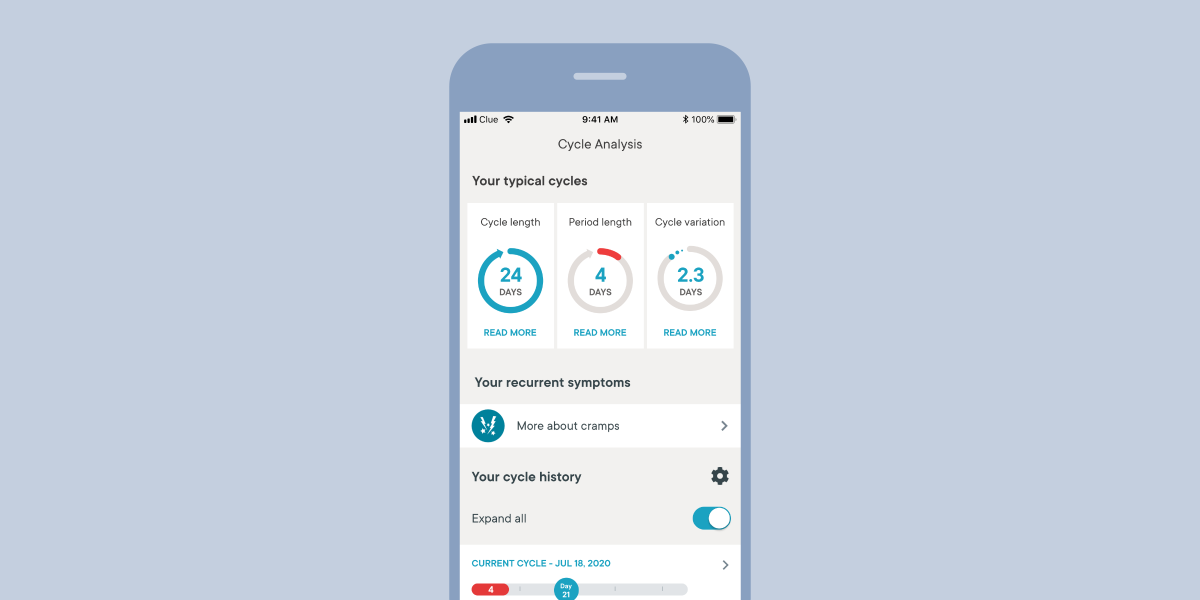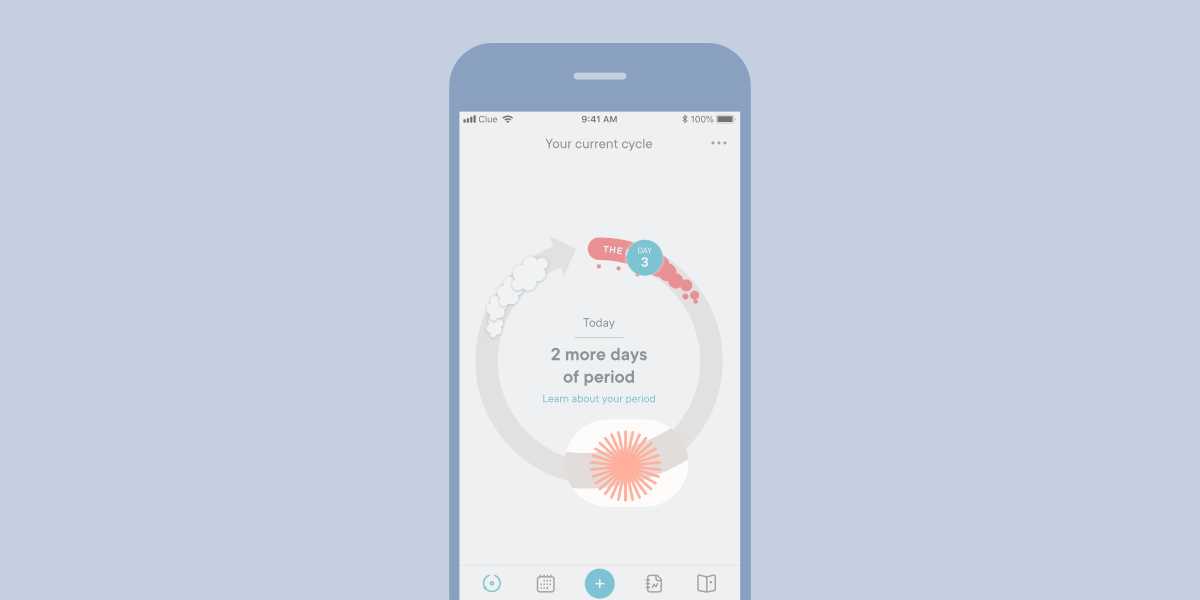Illustration by Marta Pucci
How to use the Clue app to help you become pregnant
Track your periods, body temperature, cervical fluid, and ovulation tests.

Top things to know about how Clue can help you get pregnant:
Tracking your menstrual cycle can help time sex or assisted reproductive technology (ART) around ovulation
Timing sex around ovulation increases the likelihood of becoming pregnant
Most menstrual cycles are not perfectly predictable, and that is OK!
Having a good understanding of the menstrual cycle is useful when trying to conceive (1). Tracking your menstrual cycle can help you time sex or your planned assisted reproductive technology (ART) around ovulation. Timing sex around predicted ovulation is shown to increase the likelihood of becoming pregnant (2). Tracking can also help you notice patterns or variations in your cycle that you may want to discuss with a healthcare provider (1).
You can track your cycle, ovulation test results, and other signs of ovulation in the Clue app. Typically, one ovum (immature egg) is released each cycle. This ovum will only live 12-24 hours after leaving an ovary if it does not connect with a sperm through fertilization (3). Cycle tracking and signs of ovulation, such as cervical mucus and ovulation tests, are effective methods in predicting ovulation and timing sex for pregnancy (4).
Cycle predictability and length
If you have tracked at least three cycles in Clue, the app will establish a baseline for your period predictability and cycle length.
Most people do not have perfectly predictable cycles (1). Cycle lengths between 24-38 days are generally considered typical (3, 4). Slight variations between cycles is common and should not interfere too much with timing sex around ovulation (3).
Very long or very short cycles may suggest that ovulation is occurring infrequently or not at all (3, 5). Cycles that often have large differences in the days between periods can make it difficult to track signs of ovulation and time sex (6). There are some conditions that may impact how predictable your period is, like polycystic ovary syndrome (PCOS) (5, 7).
Where can I view my past periods and cycle history in the Clue app?
To see an overview of your previous periods and cycles in the Clue app, tap on the Analysis tab (it looks like a little line graph to the right of the + button) and it will bring you to a screen that looks like this:

If you currently use Clue Plus, you’ll be able to see an enhanced version of the Analysis screen. This will tell you your typical cycle length (the number of days between the first day of your period and the day before your next period starts), your typical period length (the number of days of bleeding each cycle), and the typical cycle length variation (a measure of your cycle’s changes from one cycle to the next).
What is the biological fertile window?
Your biological fertile window consists of the five days leading up to and the day of ovulation (8). Unprotected sex during these days allows the possibility of conception (sperm and egg joining) (3, 5).
Ovulation occurs when one of your ovaries releases an egg (3). The egg can be fertilized for up to 24 hours as it journeys through the fallopian tubes towards the uterus (3). Sperm can live inside the body for up to five days before ovulation; this is affected by how well the sperm move and the amount and type of cervical fluid present (6).
Having sex or being inseminated during the fertile window, particularly the two days right before ovulation, increases your chances of pregnancy (9).
Your predicted day of ovulation will look like this in the Clue app:

Clue is not a diagnostic tool. It can help you pay attention to the predictability of your menstrual cycle and track your signs of ovulation to better understand your body. This may be helpful if your goal is to become pregnant.
What should I know about basal body temperature?
Basal body temperature (BBT) is the body’s temperature at rest. Reproductive hormones have a measurable impact on the body’s temperature (3). After ovulation, there is a rise in the hormone progesterone (3). This rise in progesterone causes a slight (0.4-1.0℉) increase in temperature (3, 10). To monitor BBT, it is recommended to use a special basal thermometer that measures tenths of a degree (3). BBT should be taken immediately after waking up while still laying in bed and before sitting upright (3). BBT should be charted everyday on a paper or electronic chart with a line connecting the temperatures (3).
The American Society of Reproductive Medicine (ASRM) states that although BBT can be an affordable option, it is not a reliable ovulation monitoring method for all people and is a lot of work (1). The American College of Obstetrics and Gynecology (ACOG) states that BBT is not a good method for trying to conceive or prevent pregnancy because it changes after ovulation has already happened (3, 10). On top of this, interrupted sleep, fevers, medical conditions, stress, and alcohol can potentially hide the BBT increase that is a sign of ovulation (10).
Why should I track cervical fluid to become pregnant?
Tracking cervical fluid can be helpful if you are trying to become pregnant (3, 11). Cervical fluid affects the ability of sperm to travel through the reproductive tract and how long sperm may survive (11).
As ovulation approaches, more cervical fluid is produced and the fluid becomes more stretchy, clear, thin, wet, and slippery—like a raw egg white (3, 11). Some people also call cervical fluid "ovulation discharge". After ovulation there is less discharge, and the mucus is thicker (11). Having sex when cervical fluid is thin and slippery can increase the chance of pregnancy (3, 11).
Note: Clue allows you to input data about your cervical fluid, but Clue’s algorithm currently doesn’t use this information to estimate the length or timing of ovulation.
Track ovulation tests for more accurate ovulation predictions
In the Clue app, you can track when you use at-home ovulation tests. There are two different types of home ovulation prediction tests/kits (OPKs) that you can purchase over the counter (12). OPKs either identify luteinizing hormone (LH) or LH and the estrogen metabolite, estrone-3-glucuronide (E3G) (12).
An LH surge (quick rise) is a sign that ovulation may happen in 24-36 hours (12). Ovulation tests identify LH surges 9 out of 10 times if their instructions are followed correctly (12). After entering a positive ovulation test in Clue, your cycle view and calendar will change to match this ovulation test result. The data will also be used to determine the length of your luteal phase (time from ovulation to the day before the first day of your next period). Using ovulation tests will make Clue’s period and ovulation predictions more accurate.
I can’t see my predicted ovulation day in the Clue app. What should I do?
To display the predicted day of ovulation in the Clue app, go to the Menu. The Menu icon is in the top right-hand corner of the Cycle View in your Clue app and looks like three dots. Tap on the icon, then tap Settings and then tap on the Ovulation tab. On this page, next to “Show potential ovulation day,” tap the toggle to turn it on. The screen will look like this:

Can I get pregnant at any time during my cycle?
A common misconception is that you can only get pregnant on the day of ovulation, or that you can get pregnant at any time. This is not the case—to become pregnant, active and alive sperm must be in the reproductive tract when the body releases an egg (3).
Using ovulation tests, Clue’s estimated ovulation day, and monitoring your cervical fluid can give you a better understanding of your fertile window—the days when you have a higher chance of conceiving.
If you are trying to prevent pregnancy, you should not use Clue’s predicted day of ovulation as a form of birth control. Using signs of fertility to avoid pregnancy requires more rules and diligence, compared to using them to get pregnant. If you do not want to become pregnant, you should follow a formal form of natural birth control and/or use another form of contraception, like condoms or combined oral contraceptive pills, to prevent pregnancy.
Becoming pregnant is a science that has a lot of unknowns and often requires time and patience. Self care is important. Consider joining a support group or activity that you enjoy and that decreases stress.
Clue’s in-house clinical team is working on a new tool to help people trying to conceive. Follow us on Instagram for upcoming product release dates.
A previous version of this article was published on May 17th, 2019.
